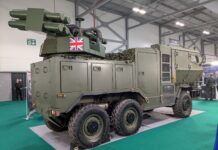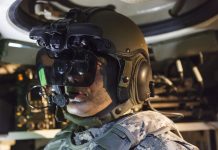Small, adaptable, and increasingly autonomous, unmanned systems are increasingly reshaping the battlefield and changing how military operations are conducted, with numerous countries and non-state armed groups demonstrating their potential in conflict zones.
During his long career as a member of Hamas, and as its leader in Gaza since February 2017, Yahya Sinwar probably accepted a growing risk that this could end with his death in combat with the Israel Defence Forces (IDF). That risk became reality on 16 October 2024 when an Israeli drone observed him entering a building in the southern Gazan city of Rafah.
Seemingly already injured in a firefight, he was then located within the building by what may have been the same drone. Small enough to be able to fly into the building via a window, it hovered in the room, then moved forward into the next room, where Sinwar could be seen seated in a chair, from which he threw a stick at the drone. Initial reports suggested that he was subsequently killed by gunfire from an IDF tank, but a later autopsy showed that he had been fatally injured by a bullet wound to the head.
In many ways it is surprising how much things have changed in such a short time. When the US began using uncrewed aerial vehicles (UAVs) for reconnaissance purposes during the 1960s, these were relatively large, and flew at medium altitudes. This trend remained relatively steady for many decades, but recent conflicts have seen of small drones become near-ubiquitous, with an exponential increase in usage over the last three years. These are often adapted versions of the commercially-available drones flown by enthusiasts, with many being rotary-winged, and able to move or hover as required. Press reports from Gaza have described the near-constant buzzing sound created by Israeli drones; a sound so common that among Gazans it has now made its way into slang as ‘Zanana’.
OWA drones and decoys
Israel remains fairly tight-lipped regarding its tactical drone capabilities, but drone operations by both sides in the current conflict between Russia and Ukraine give significant insight into this rapidly-evolving technology. Following the start of its full-scale invasion of Ukraine in February 2022, Russia began importing Shahed one-way attack (OWA) drones from Iran, and later launched a programme to manufacture these in Russia as ‘Geran’ drones. The intensity of Russian drone attacks against Ukraine increased sharply during 2024. This may have been facilitated by a major expansion of a drone factory in the Alabuga Special Economic Zone, in Russia’s southern Tatarstan region. The facility is thought to be manufacturing Iranian-designed attack and surveillance drones. Russia’s Geran-2 version of the Iranian-developed Shahed-136 is probably the main product at the Alabuga plant.
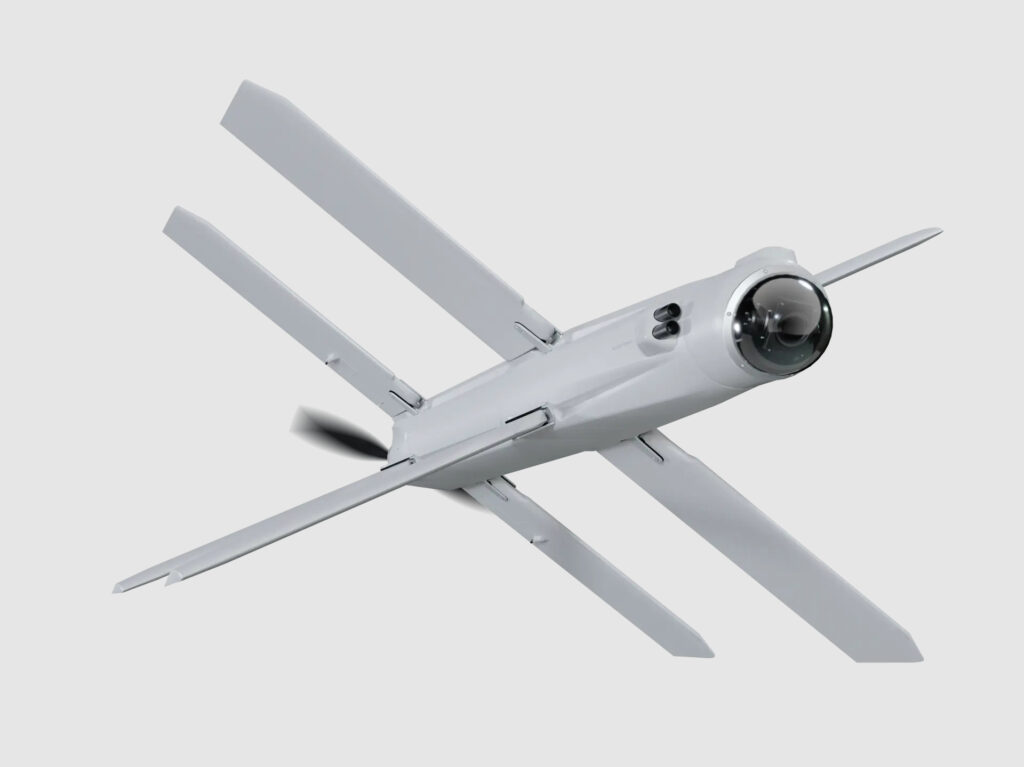
Ukraine has been more forthcoming than Russia at releasing information regarding its drone operations. Its Aerorozvidka military organisation has created the R18 octocopter, with eight rotor blades, a flight time of 40 minutes, a thermal imager, and a carrying capacity of five kg. This allows it to carry loads such as three RKG-1600 bombs. Created by adapting Soviet-era anti-tank hand grenades, these bombs weigh around 1 kg. A further example is the hexacopter Vampire developed by the Ukrainian company Skyfall. Fitted with a thermal camera for nighttime operations, it can carry up to 15 kg of munitions, and can be used to target AFVs, ammunition depots, and a wide range of defensive structures.
In 2023 Ukraine started to make extensive use of what are termed ‘first-person view’ (FPV) drones. These transmit video imagery that operator can view using goggles similar in function to virtual-reality headsets. Small and relatively inexpensive, these were adapted for military use by attaching explosive payloads such as anti-tank grenades and rocket-propelled grenade (RPG) warheads. This improvised armament was often fixed in place with crude methods such as plastic cable ties, and often used fairly primitive fuzing, but the result was a weapon that was cheap enough to be regarded as ‘one-shot’ and worked by crashing into its target. At first, the drones that Ukraine was using over the battlefield could obtain imagery only by day, but by the end of 2023 drones fitted with thermal cameras were allowing night-time attacks to take place.
Ukraine has also explored alternatives to kamikaze-style attacks by arming some FPV drones with reuseable weapons such as shotguns or grenade launchers. The autumn of 2024 showed video evidence of what may be another reusable payload, with the release of video showing a drone flying along a Russian trench line and releasing a continuous stream of incendiary material purported to be thermite powder.
For Ukraine, long-range OWA drones are its only method of attacking targets deep in Russia. For example, on 10 November 2024, Russia claimed that it had successfully engaged 84 Ukrainian drones, some of which had been approaching Moscow. What Ukraine claimed was the largest-scale attack against military targets deep inside Russia was conducted on the night of 13/14 January 2025. Targets were reported to have been between 200 km and 1,100 km distant, and included sites in the Bryansk, Saratov, and Tula oblasts, as well as in the Republic of Tatarstan. On 20 January, Ukraine claimed to have attacked military facilities in Kazan, including the SP Gorbunov Kazan Aviation Plant, which produces Tu-22M3 and Tu-160 strategic bombers. An attack against a bomber base at Olenya in Murmansk reported in July 2024 would have involved a flight of around 1,700 km, close to the 1,800 km maximum drone range claimed by Ukrainian Deputy Prime Minister Mykhailo Fedorov in a December 2024 interview. Production of these long-range drones has been increased on a large scale, he stated, and the plan for 2025 is to manufacture up to 30,000 units.
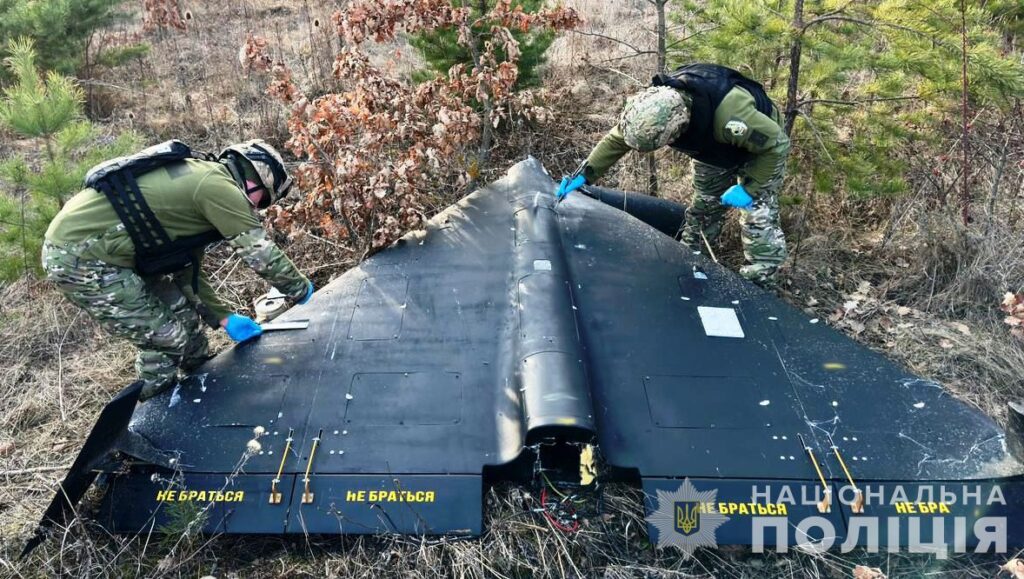
A December 2024 report by the Washington-based Institute for Science and International Security noted the Russian use of two types of decoy drone during missile and drone strikes on Ukraine. It identified two types – the Gerbera and the Parodiya – both of which were intended to mimic threats such as the Geran-2. The report noted “Both of these drones can be mass produced quickly and are built from simple materials like plywood, foam, and a few electronics”.
Such simple construction makes these much less expensive than the threat systems that they are emulating. As a result, they can be launched in large numbers at the same time as missiles and OWA drones. Since Ukrainian air defenders have no way of distinguishing between threats and decoys, they are forced to engage both, expending large quantities of anti-aircraft missiles and ammunition, and thus reducing their available stockpiles. Initially, these Russian decoys were unarmed, but were soon reported to be carrying an explosive payload and being directed towards ground targets that do not warrant the use of a full-sized OWA drone.
One potential method of countering drone attacks is to use a ‘friendly’ drone to attack the intruder. This concept has been adopted by both Ukraine and Russia. In 2024 Ukraine launched a competitive evaluation of interceptor drones, and by the end of the year had fielded a system that has since been credited with around 20 interceptions. Shotgun-armed Ukrainian drones have been used against ground targets including individual infantrymen, but have also taken part in air-to-air engagements against Russian drones.
Sea and land drones
Attacks by Ukraine against Russian warships have been successfully mounted by means of uncrewed surface vessels (USVs), but Russia responded by using fixed-wing aircraft and helicopters to engage these attackers.
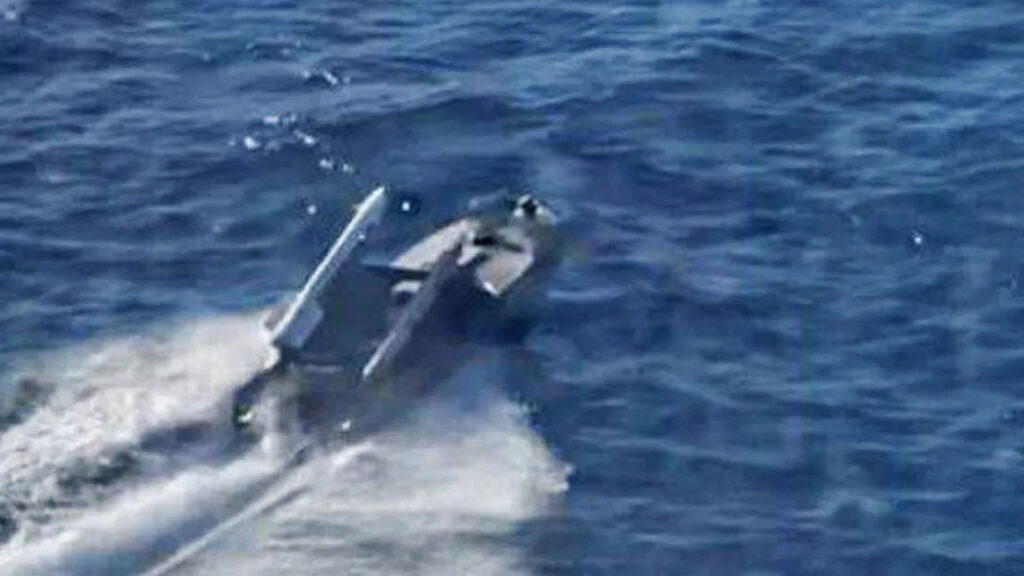
One method of increasing the range of FPV drones is to air launch them from a location close to where they are needed. In September 2024 the Telegram messaging service displayed a Russian video sequence that showed two operators releasing a drone from a helicopter flying in an over-water location. One man was shown launching the drone from the door of the helicopter, while another wearing what looks to be an FPV headset seemed to be operating a control unit.
The representative of a Ukrainian brigade operating in what was described as “the Kharkiv direction” reported on 20 December 2024 that on an unspecified earlier date Ukrainian forces had conducted their first ground attack made exclusively using robotic systems instead of infantry. Carried out near Lyptsi (north of Kharkiv City), the attack had involved “dozens of UGVs equipped with machine guns”, and purportedly successfully destroyed a number of Russian positions. Other UGVs had been used to lay and clear mines in unspecified locations in the area, the spokesman stated.
At least five types of UGV are known to have been developed under Ukraine’s Brave1 programme:
- Ratel-S is a small wheeled vehicle able to carry a payload of anti-tank mines or other explosives weighing up to 35 kg. Its operating time is 40-120 minutes (depending on speed).

- IronClad uses a hybrid power plant able to produce off-road speeds of up to 15 km/h for up to 13 hours. It carries a Shablya M2 turret, equipped with day and thermal cameras, and is provided with a level of ballistic protection to resist enemy small-arms fire. The turret can be armed with a 7.62 mm or 12.7 mm machine gun. While the vehicle is reported to have a range of 130 km, the command link has a range of only 5 km, or 10 km if a repeater is available; or just 1 km if the fibre-optic cable option is used.
- Described as a “reconnaissance and strike ground robotic complex”, the D-21−11 combines a D-21 logistical ground robotic chassis with the D-11 – a stationary ground combat module that allows an operator to aim and fire its weaponry against enemy personnel, light armoured vehicles, and helicopters flying at low altitude.
- Volya-E is a radio-controlled tracked vehicle developed for logistic tasks such as the delivery of cargo and provisions. Initially fielded to carry up to 150 kg, it was soon being tested with 300 kg payloads.
- FoxTac was developed to evacuate wounded soldiers from the battlefield, and take them to a front-line location where they can be transferred to a medical evacuation vehicle.
The growing role of fibre-optics
Both sides in the Ukrainian conflict have made large-scale use of jamming in order the disrupt drone operations by the enemy. Operations with drones that relied on RF links are still possible, despite the growing level of jamming, but this technique is slowly becoming unviable. One 2024 estimate claimed that up to 75% drone sorties by both combatants were being affected. Fibre-optic links proved a workable solution to the jamming problem. For example, the widely-used quadcopter drones could be fitted with a belly-mounted spooling mechanism able to disperse an optical fibre which allowed higher-bitrate data exchange, worked even at very low altitudes, and was immune to jamming.
In early 2024, the Russians were documented as having started to use drones controlled by optical fibre. Later in the year, commentators noted that these were limited in range by the length of the fibre, and noted that the fibre system posed a weight penalty, and could face problems due to the trailing fibre becoming caught on obstacles. The need to avoid terrain features that could snag or break the fibre is a significant factor that may reduce the range of a fibre-optic guided drone.
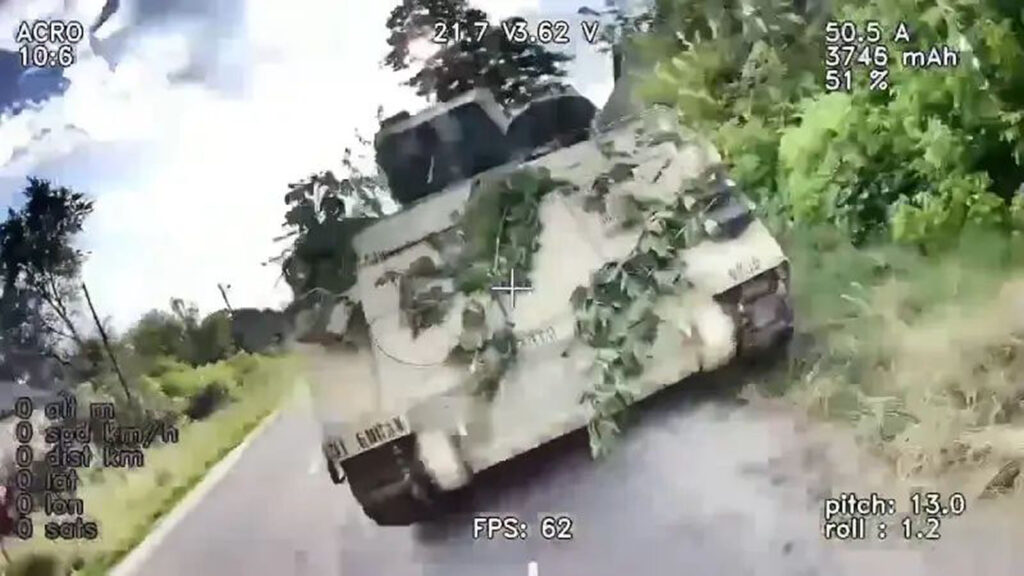
Swarms and AI
During operations in Gaza in mid-May 2021, the Israel Defense Forces (IDF) were reported to have begun using a swarm of small drones to locate, identify and attack Hamas militants. A networked entity that incorporates artificial intelligence, these swarms were understood to require only a single human operator to direct them towards targets, and be able to keep operating even if many of its individual members were jammed or shot down.
One factor that may encourage the deployment of swarms is the trend towards smaller UAVs. This raises the inevitable question of just how small future drones might be. Originally developed by the Norwegian company Prox Dynamics AS, the Teledyne FLIR Black Hornet Nano is only 168 mm long and weighs less than 33 g, but can transmit live video or stills back to its operator from its low-light day and thermal cameras. In 2017, Israeli Minister-without-Portfolio Ayoub Kara claimed that some future drones might be as small as flies, and could become operational within three years, but to date no hardware of this size has been publicly announced.
Many current types of precision-guided weapon offer a ‘man-in-the loop’ capability that allows the operator to observe seeker imagery during the final stages of weapon flight in order to ensure that a valid target is being attacked, or to break off the engagement if this proves necessary, either because the target is not valid, or in order to prevent civilian casualties. However, the technology needed to create a fully-autonomous weapon able to identify and attack a pre-defined class of target already exists. The robotic killer drone able to identify and attack a pre-defined class to target is no longer a future development, but may already have been used operationally.
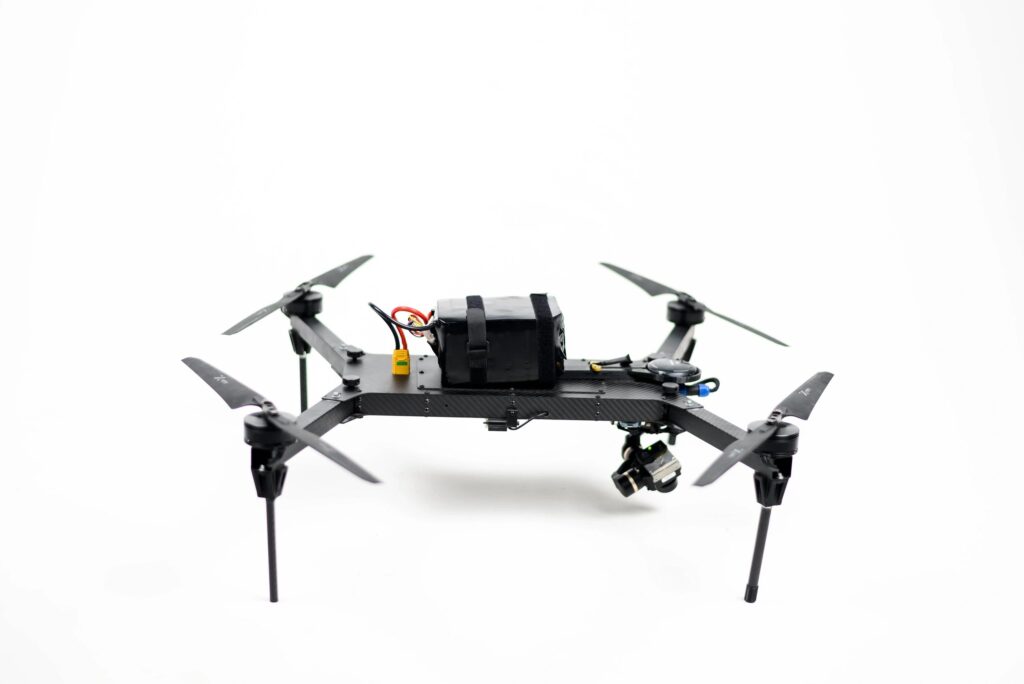
Autonomous target-recognition may not come with a high price tag. In November 2024 the UK newspaper The Daily Telegraph demonstrated how a commercial off-the-shelf drone could be given fully-autonomous homing capability. Luis Wenus, described by the newspaper as “a young Norwegian tech entrepreneur who is concerned about the use of drones as weapons” modified an inexpensive commercial drone into a potential assassination device in just a few hours. The journalists uploaded a facial image of one of their number into the modified drone, which was then released into a rented conference room being used for the demonstration. During its subsequent autonomous flight, the drone was able to manoeuvre around room features such as pillars and chairs, and check the facial features of anyone it could see before recognising and flying into its pre-programmed victim.
Drone ‘motherships’
Another emerging technique is to use a UAV to launch smaller UAVs. This allows the latter to be used in locations beyond their normal operating range. Several notable developments have happened in this sphere within the last few years:
- In early January 2025 Ukraine claimed to have used USVs to launch drone attacks against Russian targets on the coast of the Black Sea, and released imagery showing an attack mounted against a Pantsir-S short-range air defence (SHORAD) system.
- In September 2024, Russia revealed the Burya-20, an aircraft-style drone able to fly more than 60 km from its ground control station, release a number of FPV attack drones, then act as a communications relay station for these.
- In 2022 Ukraine had begun to field the Dovbush T10 reconnaissance drone, but it has now adapted this as a drone mothership. In this role the T10 can carry up to six FPV drones, then act as a communications relay once these have been released.

- In 2021 the Chinese company Zhongtian Feilong conducted a test flight of a drone able to carry and release multiple smaller drones that could form a swarm. It released a video showing a ‘mothership’ releasing nine smaller drones. According to the company, the location, speed, and direction of each release could be configured to allow the mini-drones to form a swarm. A team lead by Professor Shi Zhiwei of the Nanjing University of Aeronautics and Astronautics is reported to have taken the air-launched concept a stage further by developing a drone that can separate mid-flight into two, three, or even six smaller drones, each able to perform specific roles.
A look to the future
Ukraine became the first country to establish a dedicated military force to operate uncrewed systems. The Unmanned Systems Forces (USF) was created in June 2024 operate unmanned military robots on land, sea, and air.
Speaking at the Royal United Services Institute (RUSI) in London on 10 December 2024, Deputy US Secretary of Defense Kathleen H. Hicks said “Every war offers a window into how future wars will be waged. Unquestionably, Russia’s war against Ukraine has much to tell us. . . we’re seeing novel applications of both old and new technologies, some of which will be significant factors in how wars of the future will likely be fought.”
Like the first use of Mark I tanks at the Battle of the Somme in September 1918, the Ukraine’s pioneering use of an all-robotic attack force late in 2024 had little effect on the overall position of the front line. However, just as the tanks used on the Somme gave a first glimpse of the role that tanks would play in future battles, perhaps current operations by Ukraine and Russia will mark the beginning of an era in which drone wars will be fought over and on future battlefields. Yet one thing seems certain – just as the tank spurred the development and deployment of anti-tank guns and other anti-armour weapons, the drones of today are already providing impetus for the development of a new generation of anti-drone defences.
Doug Richardson





![IFPC Increment 2: Filling the medium-range gap The IFPC Inc 2 AD system is intended to defend fixed and forward operating bases against the latest and emerging aerial threats including rotary and fixed-wing, UAVs and cruise missiles, most likely using a second, more capable interceptor. [US Army]](https://euro-sd.com/wp-content/uploads/2025/09/1-IFPC-Increment-2-system-Credit-US-Army-Kopie-218x150.jpg)

